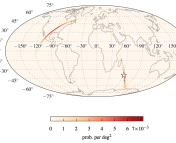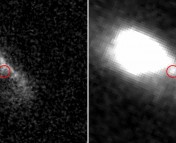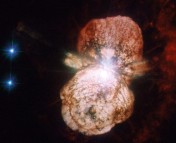- Title: James Webb Space Telescope can Detect Kilonovae in Gravitational Wave Follow-up
- Authors: Imre Bartos, Tracy L. Huard, Szabolcs Marka
- First Author’s Institution: Columbia University
- Paper Status: Submitted to The Astrophysical Journal
Hopefully by now you have heard about just how awesome the James Webb Space Telescope will be (cue the George Lucas styled teaser…). In short, the Webb telescope is the successor to the famous Hubble Space Telescope — but the Webb telescope is much more than that. Using a mirror seven times the size of Hubble’s and its multi-object spectrograph, Webb will be able to study hot topics like the atmospheres of distant planets or the hectic lives of the earliest galaxies. Its capabilities seem only limited by our collective imagination — which is why scientists share their ideas for Webb as white papers on the arXiv. White papers are those which are not designed for publication in the typical scientific journals; they are a mean for scientists to informally share ideas to a wide audience. The Webb has no shortage of such papers. Today’s paper is actually a submitted article in which the authors propose the idea of marrying Webb with another major instrument: LIGO.
LIGO and Kilonovae
The Laser Interferometer Gravity Observatory (LIGO) is made of two massive Michelson interferometers which can detect extremely small spatial fluctuations using a high-powered laser. These tiny fluctuations aren’t caused by seismic tremors or LSU football games; they are actually ripples of spacetime called gravitational waves. These waves originate from a number of astrophysical events, but today we’ll be focusing on just one type known as the kilonova.
Kilonovae are a result of the collision of two compact objects, such as two neutron stars. Before the neutron stars collide, they will spiral inwards, causing massive gravitational waves. LIGO will hear this inspiral as a “chirp,” while telescopes will see this collision as a bright explosion that is about 1000 times as bright as a classic nova (hence the name “kilonova”). Due to the complex nucleosynthesis of kilonovae, these objects are brightest at longer (infrared) wavelengths of light (You can read more about that process in this astrobite.)
Unfortunately, LIGO hasn’t detected any gravitational waves yet. But have no fear! Scientists are working on a network of updates to LIGO to create Advanced LIGO which should be 10 times more sensitive to gravitational waves. Advanced LIGO will be able to detect kilonovae as far as 1 billion light years away. There is one problem: Advanced LIGO will not be able to constrain the location of the kilonova very well — only to about 10 square degrees, or 1% of the sky. If we want to follow up LIGO detections with telescope observations, we need to search this area of the sky efficiently because kilonovae will dim dramatically a week or so after their explosion. If kilonovae were as bright as supernovae, this would be an easy task: just look for the brightest thing on that patch of the sky. Unfortunately, kilonovae are actually fairly dim; they only peak at around 24th magnitude in the optical (although they are 1000 times brighter in the infrared).

Figure 1: Cartoon of the James Webb searching only a few galaxies in LIGO’s detection beam to find a kilonova.
Webb to the Rescue
The authors of today’s paper argue that the Webb telescope is a great tool for finding the source of LIGO’s detections, as shown schematically in Figure 1. They offer a few, interconnected reasons of why we should use the Webb. First, Webb will have a near infrared camera. As previously mentioned, the infrared is approximately where kilonovae should be brightest. Additionally, because Webb hosts a huge primary mirror, it is capable of detecting a kilonova within a two second exposure. Figure 2 shows this exposure time as a function of filter and days since the kilonova explosion. Finally, Webb is equipped with an array of microshutters, which can be used independently. This drastically cuts back on the time it takes the Webb to read out images from its camera.

Figure 2: Webb can detect kilonovae quickly. This plot shows the total integration time needed to detect a kilonova ~1 billion light years away as a function of the time since explosion. Within a week of the explosion, the IR camera of Webb can detect these kilonovae in less than 2 seconds.
This all sounds great, but there is one major setback. Webb’s slew time (or the time it takes the telescope to change positions between observations) is very slow. In fact, if you naïvely used the telescope to observe the entire 10 square degrees in question, it may take over 50 hours to find the explosion!
Bartos and collaborators suggest taking a systematic approach to searching to the kilonovae. Previous studies have shown that kilonovae often occur in places with many stars forming (or galaxies with a high “star formation rate”). These star-forming galaxies often have strong H-alpha emission from the hot ionization of atomic hydrogen. Simply put, this means that galaxies with strong H-alpha emission are more likely to host kilonovae. Therefore, if we limit our Webb search to just known galaxies with substantial H-alpha emission within 1 billion light years of Earth, we can reduce the time to survey the 10 degree squared region to just 2-3 hours, depending on the number of galaxies.
With such a short time commitment, the Webb telescope will be able to follow up many LIGO targets over multiple nights, giving us unprecedented access to kilonova light curves and statistics. Hopefully, these observations can help us better understand the neutron-rich atoms (r-process atoms) and the equation of state for neutron stars and other compact objects.





Very nice post! I had not thought before of having different instruments working in collaboration to find sky objects! One question that I have though is about why LIGO can detect the shock waves but not the exact location where those waves are coming from?
Hi Tabata – You can think of your ears as analogy – often you can detect a sound but have a somewhat poor idea of where this sound came from. Advanced LIGO will be capable of detecting gravitational waves, but it will have relatively poor localization compared to most telescopes. Adding more detectors would greatly improve our ability to locate sources of these gravitational waves.
Interesting post! If LIGO has not detected any gravitational waves yet, how do we know so much about kilonovae? Is it all theoretical or have other telescopes been more successful at detecting them?
The Webb telescope will truly change the way we look at astronomy. It’s a fascinating telescope and will expand the bounds of our observations drastically.
Very cool idea to combine the functionality of two powerful telescopes! I wonder though how will we confirm that kilonovae seen by LIGO are the exact source of the gravitational wave. Do kilonovae happen in a short enough time span to confidently pair wave measurements and visual observations? What other sources create gravitational waves, and might we confuse them with kilonovae and wrongly pair them with observations taken by the Webb?